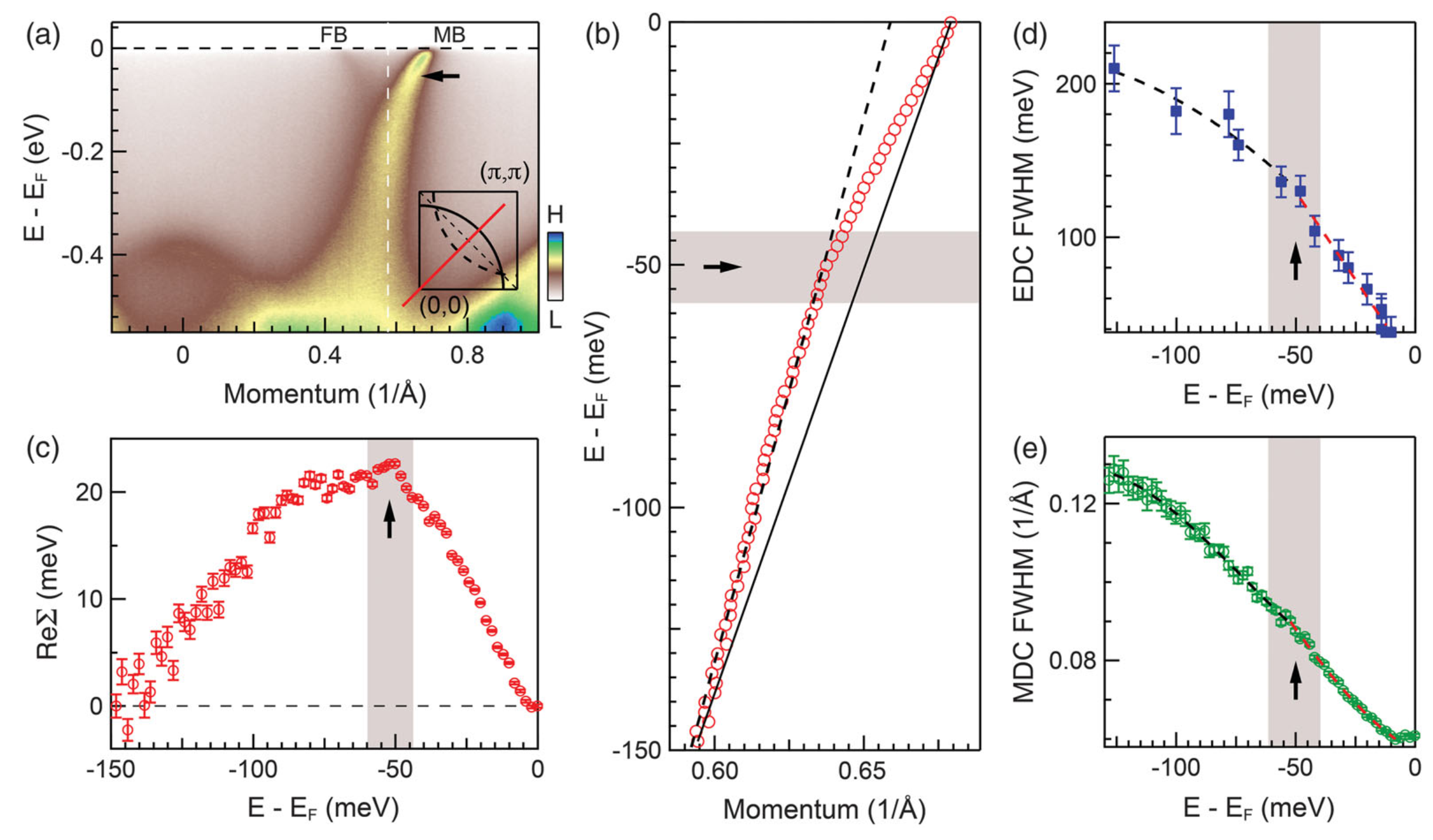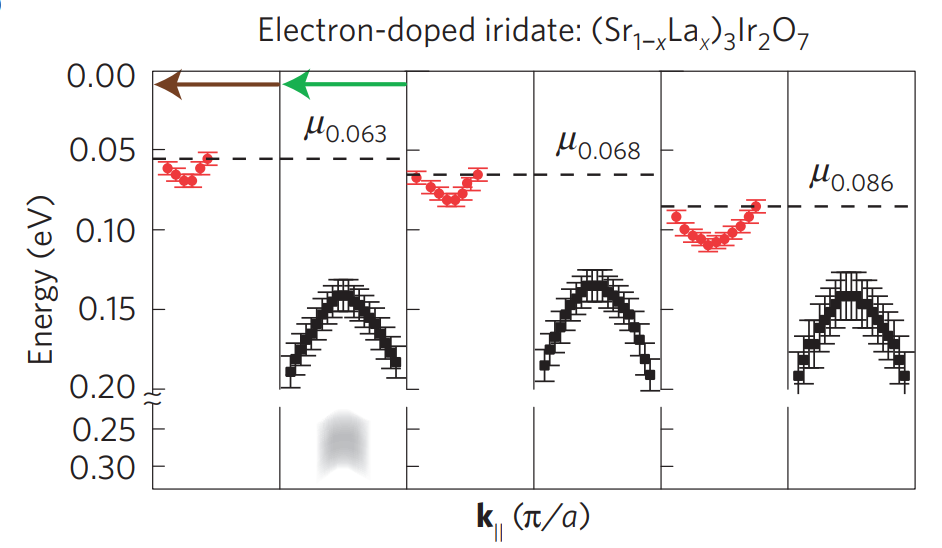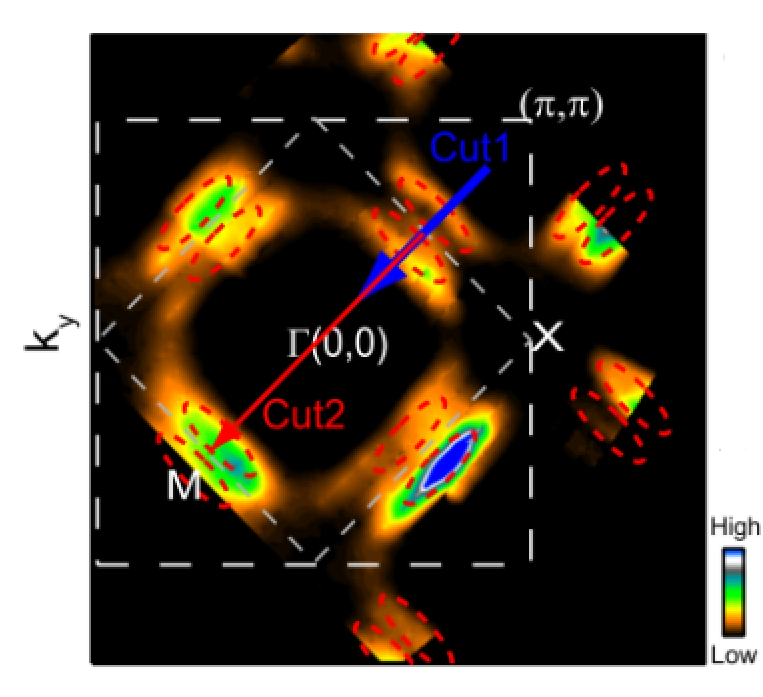Iridates
Electron-boson coupling in electron-doped Sr2IrO4

- The pseudogap, d-wave superconductivity and electron-boson coupling are three intertwined key ingredients in the phase diagram of the cuprates. Sr2IrO4 is a 5d electron counterpart of the cuprates in which both the pseudogap and a d-wave instability have been observed.
Our ARPES results present spectroscopic evidence for the presence of the third key player in electron-doped Sr2IrO4: electron-boson coupling. A kink in nodal dispersion is observed with an energy scale of ~50 meV. The strength of the kink changes with doping, but the energy scale remains the same. These results provide the first noncuprate platform for exploring the relationship between the pseudogap, d-wave instability, and electron-boson coupling in doped Mott insulators.
Yong Hu#, Xiang Chen#, ...,and Junfeng He*, Phys. Rev. Lett. 123, 216402 (2019)
Negative electronic compressibility in (Sr1-xLax)3Ir2O7
 In quantum materials consisting of multiple mutually coupled subsystems,
the compressibility of one subsystem can be negative if
it is countered by positive compressibility of the others.
Manifestations of this efect have so far been limited to
low-dimensional dilute electron systems.
In quantum materials consisting of multiple mutually coupled subsystems,
the compressibility of one subsystem can be negative if
it is countered by positive compressibility of the others.
Manifestations of this efect have so far been limited to
low-dimensional dilute electron systems.
Our ARPES reuslts present spectroscopic evidence for negative electronic compressibility in (Sr1-xLax)3Ir2O7: increased electron filling accompanies an anomalous decrease of the chemical potential. Such a phenomenon, which had been limited to low-dimensional materials where the exchange energy dominates, is shown to be primarily driven by the correlation effects in iridates crystals. This finding points to a new pathway towards realizing NEC in 3D correlated materials.
Junfeng He et al., Nature Materials 14, 577–582 (2015)
Fermi arcs vs. Fermi pockets in (Sr1-xLax)3Ir2O7
 Many exotic phenomena take place after metallicity sets in when Mott insulators are doped with carriers. A spectacular example is provided by cuprates in which high-temperature superconductivity can be realized by doping the parent Mott state. Many aspects of the transition of a Mott insulator to a metal, however, remain poorly understood. It is important, therefore, to establish the extent to which Fermi arcs are a universal feature of the electronic spectrum of a doped Mott insulator, signaling the emergence of fundamentally new physics in the material.
Many exotic phenomena take place after metallicity sets in when Mott insulators are doped with carriers. A spectacular example is provided by cuprates in which high-temperature superconductivity can be realized by doping the parent Mott state. Many aspects of the transition of a Mott insulator to a metal, however, remain poorly understood. It is important, therefore, to establish the extent to which Fermi arcs are a universal feature of the electronic spectrum of a doped Mott insulator, signaling the emergence of fundamentally new physics in the material.
We studied bulk electron-doped perovskite iridate, (Sr1-xLax)3Ir2O7, through ARPES experiments. Fermi surface pockets are observed with a total electron count in keeping with that expected from La substitution. Depending on the energy and polarization of the incident photons, these pockets show up in the form of disconnected ‘‘Fermi arcs’’, reminiscent of those reported recently in surface electron-doped Sr2IrO4. Our observed spectral variation is consistent with the coexistence of an electronic supermodulation with structural distortion in the system.
Junfeng He et al., Scientific Reports 5, 8533 (2015)